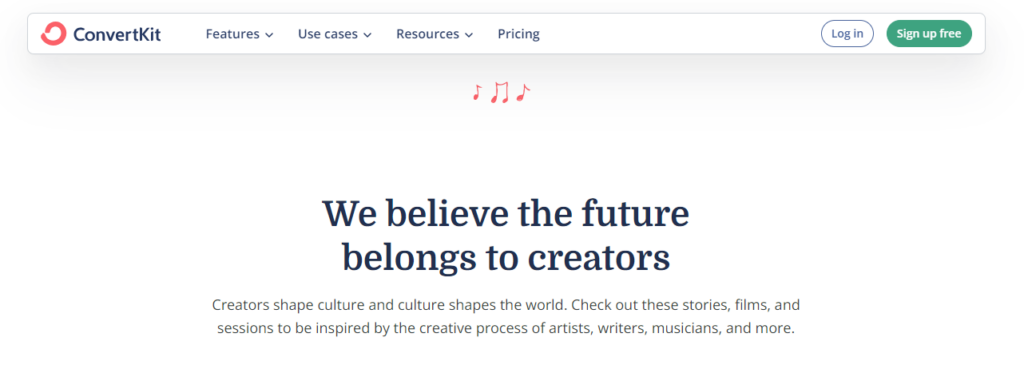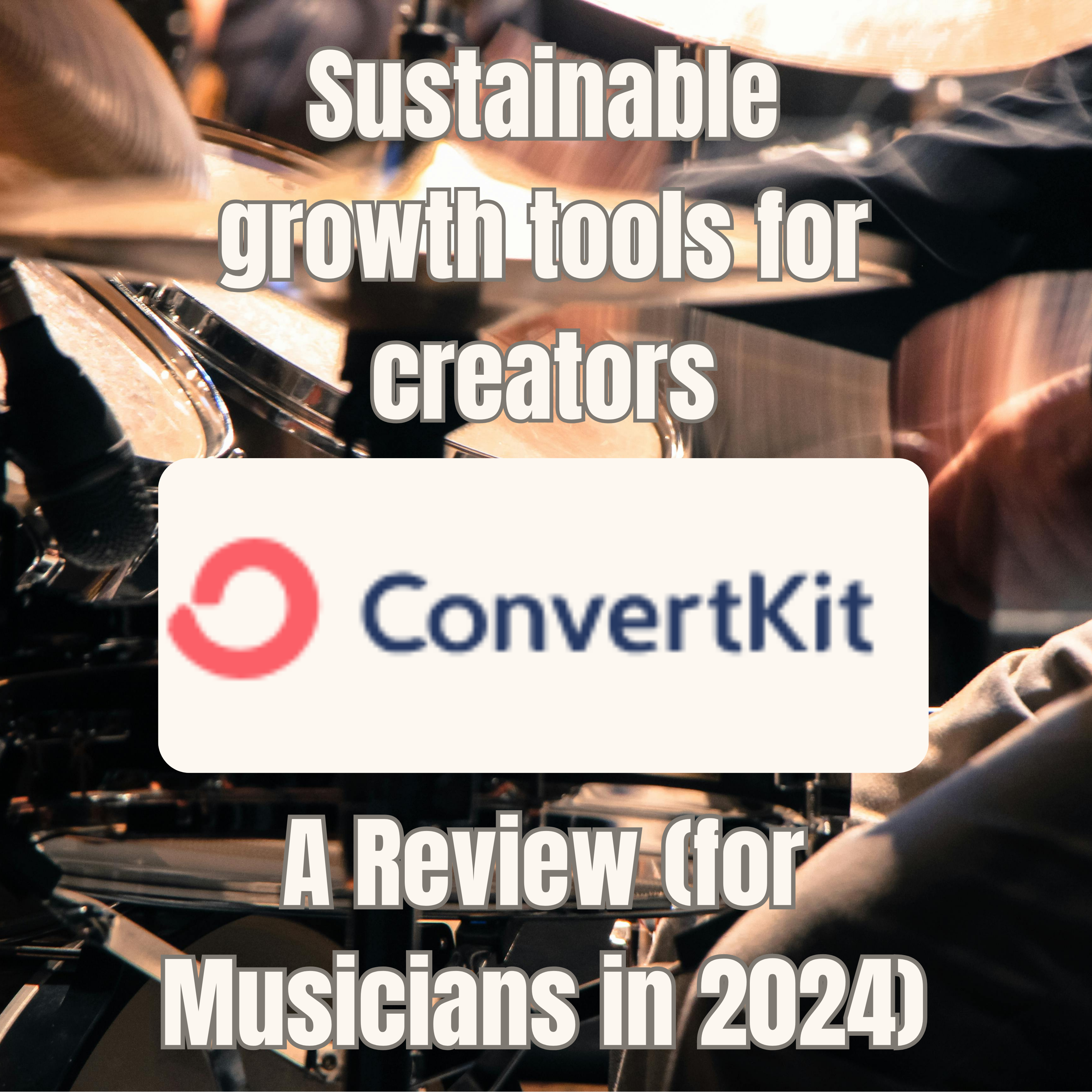There is a difference between having a mailing list and showing up on social media; the former allows you to create a direct, more personal connection with the already interested but limited audience, and the latter gives you access to a broader and new audience, but you without complete control over who will see your content – it’s up to an algorithm.
I’m biased here; I’ve had a mailing list for almost ten years, and it’s been my primary means of connecting with the community I built around my music project. I am also not a big fan of social media as a medium of expression. Don’t get me wrong, I’m not recommending that you close your social media accounts; if you want to build an audience for your music, you should be doing both.
Choosing a mailing list to promote your music can benefit your artistic career on many levels, from building a unique relationship with and steadily growing your audience to making income through selling your digital and physical products and having a reliable funnel connecting you and your fans, independent from social platforms.
There are a number of email marketing tools at your disposal; which one you should use will depend on your individual needs and budget. In this article, I will look at ConvertKit, one of the most popular email marketing platforms amongst musicians, and analyze its pros and cons to help you decide whether it’s the right choice for you.
Let’s get started.
ConvertKit: Overview

ConvertKit was founded in 2013 by Nathan Barry, a blogger and creator looking for a more efficient way to reach his audience and sell books and courses. After a couple of years of struggle, Barry, well aware of creators’ pains, decided to double down on the company and focus on email marketing products for professional bloggers.
Today, ConvertKit is an independent business helping creators make a living using email marketing. The platform is popular amongst creatives, podcasters, musicians, and small e-commerce business owners and is appreciated for its stand-out automated email funnels, flexibility, and user-friendly design.
Some musicians using ConvertKit include Lindsey Stirling, Tim McGraw, Josh Abbott Band, Drew Holcomb, and Leon Bridges, amongst others. Apparently, even Arnold Schwarzenegger is also using ConvertKit!
Prompted by the growing number of artists using the platform, in 2021, ConverKit decided to acquire an email marketing and fan management company for musicians, FanBridge. That was probably the best proof of the company’s commitment to supporting music marketing, and it had an impact on more music-orientated features being offered on the platform, like countdown timers or embedding from Spotify (I will get to the details shortly).
In 2020, the company introduced Creator Sessions, a series of online intimate sessions showcasing stories behind musicians, artists, photographers, and filmmakers’ careers, sharing details of their creative process.
ConvertKit: Service
ConvertKit is an all-around email marketing service and eCommerce solution that can be used to build your audience, connect with the fans, and monetize your music. The platform is renowned for its focus on optimization and segmentation, helping small business owners and solopreneurs boost their sales and streamline email marketing functions.
Email marketing
Email marketing is what ConverKit is famous for, and they are doing it well; the platform supports various types of emails and A/B subject line testing. You can choose from a number of customizable templates accessible to email marketing beginners and tech-savvy users alike.
Email types include newsletters, autoresponders, automated sequences, forms, and landing pages.
At first glance, the WYSIWYG editor allows only basic text and format editing, but more advanced functions are available in the “content block menu,” accessible through the “+” sign, which shows every time you hover over an element on the page. The content block menu allows you to add various customizable elements, such as CATs, countdowns, links to other platforms, embedded tweets, music, products, and videos.
A library of templates enables you to select and customize designs to easily create emails without any coding experience (although there is a possibility to add your own templates if you want to).
Email list management is made super simple with tagging and segmentation; the system lets you add various lead magnets (freebies) to the same list and tag users to decide who will receive your emails based on specified filters.
Bounced email management is a useful feature, addressing the email that didn’t go through due to issues with the email address or recipient inbox; ConvertKit will try to resend the bounced email multiple times before marking it as undeliverable (hard bounce).
The downside is a lack of a block list, which makes it tricky to identify unsubscribed emails.
Forms and landing pages
ConvertKit has a simple and intuitive landing page editor that allows you to build responsive landing pages to promote new products and redirect your audience to your social channels, streaming platforms, or websites where they can download your music. You can choose from over 50 available templates or insert a customized code to import your own format. The editing tools include a number of features; you can include links, videos, countdown timers, customizable buttons, code blocks, and more.
You can sell your physical and digital products directly from designated product pages. Transaction fee is 3.5% plus 30c.
Forms help you get new subscribers to sign up, deliver a freebie in exchange for an email address, or gather important data points; creating various forms and pop-ups with ConvertKit is really straightforward. Again, you can use the templates and add various elements, including videos, images, and active headers. You don’t have the option to add HTML blocks in the forms.
Productivity Tools and Integrations
Automations
Any musician I know would choose to make music over promoting it; ConvertKit addresses these needs with an outstanding automatization system and multiple integrations, helping artists be more productive and get better marketing results.
Visual automation tools help you organize your subscriber list or set up email flows with an intuitive builder designed to navigate your fans’ journey, incorporating your existing contact list, tags, and other elements. This could be really helpful, when launching a new album, selling merch, or if you want to introduce new subscribers to your music, sending them a sequence of welcome emails. To set up automation processes, you can use pre-built and easily customizable templates or build the funnels from scratch.
ConvertKit has the option to set up email sequences working on the “If this, then that” rule, helping you stay relevant and follow your subscribers at every step with appropriate content.
Integrations
The platform features multiple integrations, from Shopify through Might Networks to Bandisintown and Patreon. On top of over 70 integrations directly accessible through the platforms, you can access hundreds more through Zapier.
Reporting
One front on which ConvertKit is lacking is reporting; the Free and Creator plans include basic reporting functions, and only on the Creator Pro plan can you benefit from deliverability reporting. Bounce rates and conversion tracking are not included, and there is no data based on device and geolocation.
It’s somehow justified since the platform is directed towards creators and not professional marketers; still, there is room for improvement in this area.
Recommendations & Creator Network
ConvertKit is trying to help its customers make the most of its email marketing efforts by providing a recommendations system – a cross-promotion tool that allows you to recommend other creatives that you resonate with to your network. Discover people you want to recommend via the Creator Network, a creator directory with 2,845+ members; you can help other users grow their network, and in return, they will do the same for you. To benefit from it, you need to purchase a paid plan.
Customer Service
ConvertKit provides email and chat support, and its resources section features multiple articles, podcasts, guides, and case studies from creators using the platform, with various materials dedicated to musicians (e.g., this blog post: How musicians can turn fans into superfans through email marketing.). On the Free plan, you get access to community support functions, and paid plans come with live chat and email support access (priority support on the Creator Pro plan).
ConvertKit: Price
ConvertKit has three plans, including a limited free plan, and it also offers a 14-day trial.
- Free Plan will be a sufficient solution for anyone who is just starting their email marketing journey; it supports up to 1000 subscribers and lets you create unlimited landing pages, link pages, and forms. A/B testing, audience tagging, and segmentation are also available. On the free plan, you can monetize your activity through paid newsletters, selling recurring subscriptions and digital products, and accepting tips and donations from your fans. It’s worth noting that your emails will have ConvertKit branding, which can be removed on higher tiers.
- Creator Plan starts from $15/month (or $108/yearly) for up to 300 subscribers. The price of the plan increases with the number of subscribers; so, for example, with 5,000 subscribers, you will pay $79/month. The Creator Plan has everything included in the Free plan, plus access to automated email sequences, a creator network, recommendation features, free migration from another platform, and 70+ third-party integrations. You can add one additional team member to your Creator account.
- Creator Pro Plan costs $29/month ($290 if paid yearly) for 300 subscribers, and precisely as with the previous plan, the price increases synchronously with the growing subscriber base. You can check what will be the price with your current number of subscribers using the handy calculator available on the website. On this plan, you get advanced reporting (including deliverability reporting), a newsletter referral system, the ability to edit links in sent broadcasts, and subscriber scoring. It also allows you to create unlimited number of accounts with separate logins for your team members.
ConvertKit: Pros and Cons
Pros:
- Intuitive, easy to use, and user-friendly interface.
- Automated email funnels.
- Integrations with other useful platforms, such as Bandisintow, Mighty Networks, and Patreon.
- Musician-orientated features, such as countdown timers for album launches and live events.
- Embedding from Spotify.
- The ability to repeat sequences.
- Robust free plan to start with.
- Embedding from Twitter.
- Video in email function.
- One of the highest email deliverability rates across email marketing providers (average delivery rate in November 2023 was 99.73%).
Cons:
- No block list.
- Limited visual editor, making it hard to add certain elements (e.g., gifs) without templates.
- Basic landing page tools, compared with other services (e.g., Mailchimp).
- Limited testing capabilities (only subject line testing A/B is available).
- Modest reporting options (advanced deliverability reporting is available on the Creator Pro plan).
Final Thoughts
Choosing the right email marketing tool is essential, and creating a sustainable email marketing strategy that suits your schedule and personality is even more crucial. Some musicians email their fans once a month; others send multiple emails a week with promos, offers, links, and information.
Although emails are still one of the most used digital forms of communication, and research shows that 99% of email users worldwide check their emails daily, our attention span is also constantly decreasing.
If you want to build a sustainable and invested list of subscribers, you need to be able to catch the attention of your fans and keep them engaged. Think about why your fans would want to open your email before you start writing it.
Email marketing is a long game that requires dedication and commitment to achieve results; you should start an email marketing campaign around six months before each new release to maximize your impact. At the same time, it can also be a rewarding journey, helping you get personal feedback and build thriving relationships that otherwise wouldn’t come to life.
Good luck!








